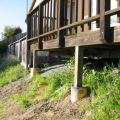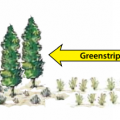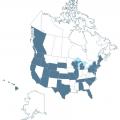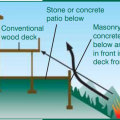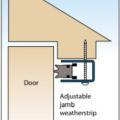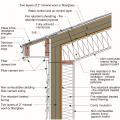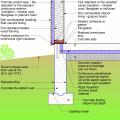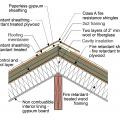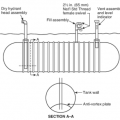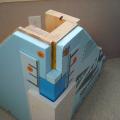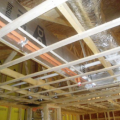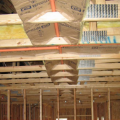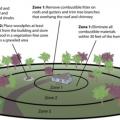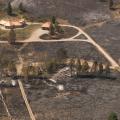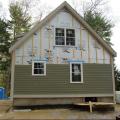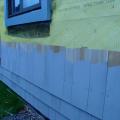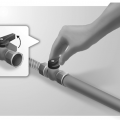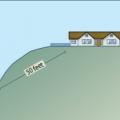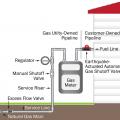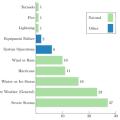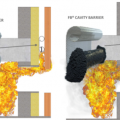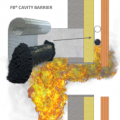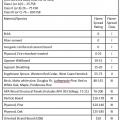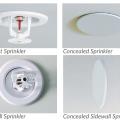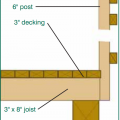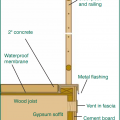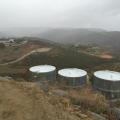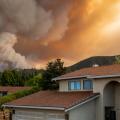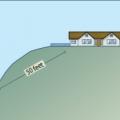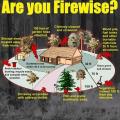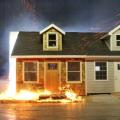Showing results 1 - 50 of 130
A Corsi-Rosenthal Box is a highly effective DIY air cleaner made of easy to obtain materials such as HVAC filters, a box fan, cardboard, and tape
A cross-section of a vinyl-framed window showing metal reinforcement which helps support the window and prevent collapse if exposed to heat from a fire.
A deck or other attached structure located at the top of a slope with vegetation underneath is at high risk of ignition during a wildfire
A dry hydrant is a pipe a homeowner can have installed in a natural water source on their rural property to provide easy access to the water by firefighting crews.
A green strip is a type of fuel break planted with less flammable vegetation; e.g., crested wheatgrass.
A patio and wall constructed of noncombustible concrete, stone, or brick helps to deflect heat and protect the deck and house from approaching wildfires.
A roughed-in fire sprinkler head (left) and fire sprinkler riser (right), both using CPVC piping.
A shaded fuel break is created on forested lands when trees are thinned, tree canopies are raised by removing lower branches, and the understory vegetation is managed to reduce the fire threat.
A wall assembly approved for use in the wildland-urban interface has 5/8-inch type X gypsum installed exterior of the wood sheathing and an exterior covering or siding that has a 1-hour fire-resistance rating
Above-ground welded-steel cistern with hydrant for fire engine hose hookup installed on private land for residential fire suppression.
Adjustable weatherstripping can be installed around the interior side of the door frame to help keep out wind-blown rain and embers and hot gasses from wildfires (FEMA 577).
Annual Wildfires and Acres Burned, including Wildland Fires on Federal and Nonfederal lands (1991-2020)
Building section connecting an unvented roof assembly constructed with fire-resistant and fire-retardant materials to a wall assembly with similar materials.
Building section connecting wall assembly constructed with fire-resistant and fire-retardant materials to a foundation assembly with similar materials.
Building section showing a vapor diffusion ridge port constructed with fire-resistant and fire-retardant materials.
Components and cross section of an underground fiberglass storage tank used for residential fire suppression.
Components of a residential underground concrete fire suppression cistern include a manhole, suction connection, vent, and fill pipes
Continuous rigid insulation coupled with thin (1/4-inch) spacer strips that provide drainage behind the wall cladding without increasing the fire risk of the assembly.
CPVC fire sprinkler piping is insulated using the tent method, as described in NFPA 13D.
Create defensible space against wildfires by limiting fire fuels in the immediate, intermediate, and extended zones around the home
Create defensible space around the home to protect it from wildfires.
Defensible space and ignition resistant building materials saved this home from a wildland fire that destroyed the neighboring home in the foreground
Drainage and back ventilation of wood cladding is provided by ¾ inch furring (1x4).
Drainage behind stone cladding is provided by “grooved” rigid insulation coupled with a filter fabric.
Drainage behind wood shingle cladding is provided by a 3/8-inch-thick drainage mat.
Every natural gas appliance has a shutoff valve in the gas line to the appliance that can be manually shut off if a leak happens at a specific appliance or in preparation for an impending natural disaster.
Example of setback from wildland vegetation Image title: Homes sited on hills in wildfire prone areas should be set back at least 50 feet from downslope wildland vegetation.
Excess Flow Valves and Earthquake-Actuated Gas Shutoff Valves are two different types of valves that automatically stop the flow of gas into the house: excess flow valves stop gas flow if there is a break in the line, earthquake valves stop gas flow if th
Extreme weather, such as wind, fire, flood, or extreme heat (included in the Severe Weather category above) causes most large electric disturbance events in the U.S (defined as affecting at least 50,000 customers) (data from 2000-2016)
Fire barriers for ventilated wall cavities use thermally activated expansive materials to close off the ventilation space between the wall cladding and the sheathing during a fire while allowing air flow through the metal mesh during normal conditions
Fire barriers for ventilated walls use heat activated intumescent expansive materials to close off the ventilation space between the wall cladding and the sheathing during a fire while allowing air flow through the metal mesh during normal conditions
Fire resistance plans for a community include creating defensible space for each home and for the whole community, constructing with fire-resistant materials, and providing turn-around space for emergency response vehicles.
Fire suppression sprinklers can be set to activate only in the room where a fire is sensed.
Flame Spread Classification and Ratings for Common Building Materials (adapted from Louisiana Office of State Fire Marshall 2021)
Four types of residential fire sprinkler heads: pendent, concealed, sidewall, and concealed sidewall.
Fully enclosing the area under the deck increases its resistance to wildfire by minimizing the space where embers can lodge.
Heavy metal flashing protects the deck timbers and separates them from the wall at the wall-deck connection which is vulnerable to both ember entrapment and water damage.
Heavy timber deck construction uses slow burning thick timbers to reduce the flammability of the deck.
Heavy timber deck construction uses slow burning thick timbers to reduce the flammability of the deck.
Homeowners in remote areas may choose to install their own cisterns to provide water for fire suppression in case of wildfires.
Homes located in the Wildland Urban Interface should be designed and constructed with fire resistance in mind.
Homes sited on hills in wildfire prone areas should be set back at least 50 feet from downslope wildland vegetation.
In this IBHS Research Center test of two homes exposed to flying embers and high winds, the home with wood siding and a wood door went up in flames, the home with fiber cement siding and a metal door suffered little damage.


